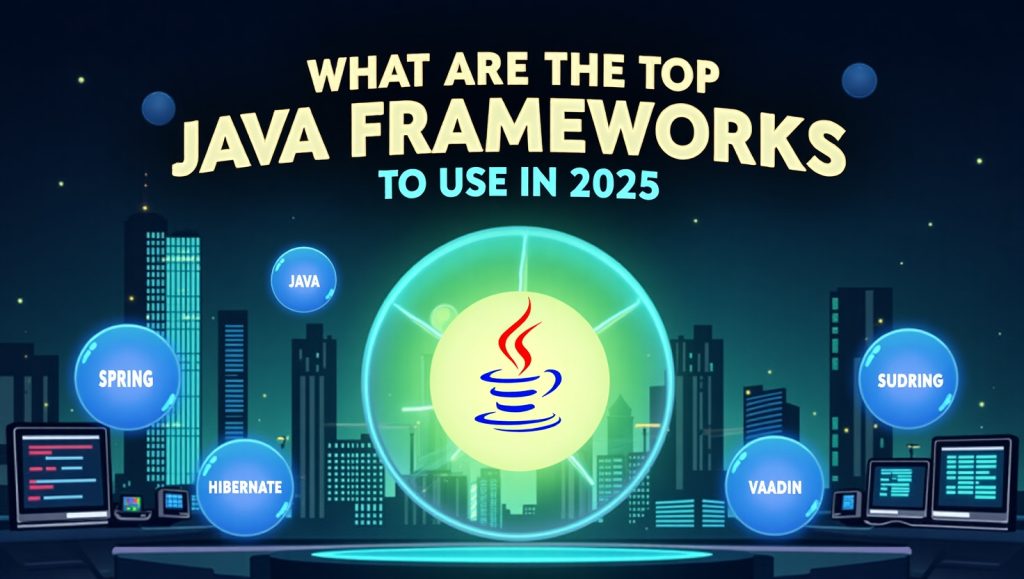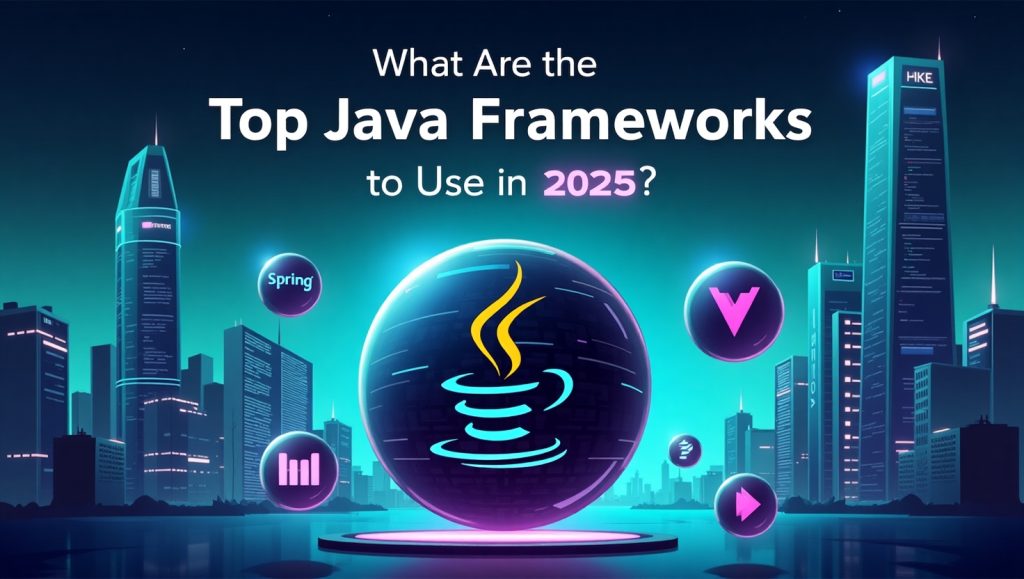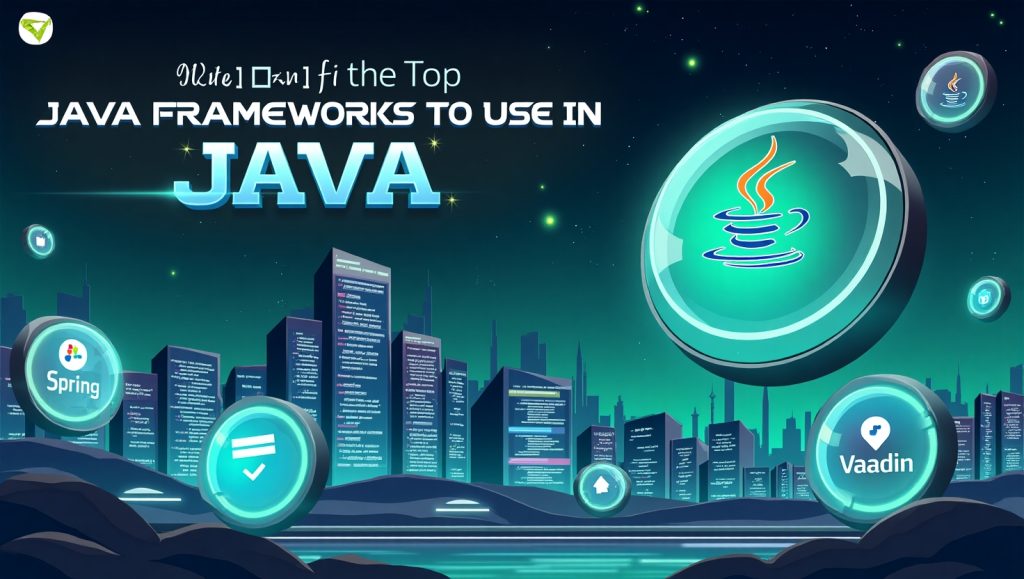
Java has always been the language standing solid for software development. From enterprise-level web apps to smaller microservices, Java does an immensely huge part of today’s tech infrastructure. However, the clearer question today, as we approach deeper into 2025, is: which Java frameworks would be concentrating on? Naturally, it would depend on individual requirements-for web itself, API constructions, or high-performance application development.
This article takes you through the best Java frameworks in 2025 with a thorough focus on what makes them unique and how they could fit into your development stack. Be you an amateur or a seasoned backend engineer, your career could take a huge leap simply by being in the know about these latest Java trends.
We would also touch on important backend web development tools and full-stack development frameworks so that you understand the larger picture of how it fits into the changing technological panorama. These frameworks are the most popular but not only that; they have also extensive support and always keep evolving to meet the challenges that software development has to face.
Spring Boot: The Backbone of Modern Java Applications
Until the year 2025, Spring Boot has remained the primary choice for a majority of developers. In essence, a project simplifies the setup of Spring-based applications, thus reducing boilerplate composed by developers during pre-Spring days. Perfect for microservices, REST APIs, or the grand name of enterprise applications.
Why is it still popular? Because it is the very basis of change. Speed, security, and developer comfort are all areas that Spring Boot continues to improve with every new release. Another big plus point for developers is Spring Cloud, a collection of cloud-native services integrated within the Spring Framework, which makes the development of large, scalable cloud-based applications a walk in the park using Spring Boot.
Apart from this, it also has great built-in support for databases, security, and third-party tools, making it much easier for the developers to concentrate on business logic rather than configuring the tech stack. It also supports various DevOps tools out-of-the-box, ensuring smooth and reliable deployment.
Therefore, if you are looking for a flexible, matured, and adaptable framework, Spring Boot should be on top of your list in 2025. It greatly supports enterprises that are into software development or cloud-based architectures.
Key Features of Spring Boot in 2025
Spring Boot 2025 is more comprehensive for features but smarter with automation. Among its important features are auto-configuration, embedded servers, production-ready metrics, and a community that contributes every day to its ecosystem.
The Spring Boot auto-configuration allows for minimal setup and basic application assembling: Add dependencies and Spring Boot configures your application. It allows you to save time to actually write your application code.
Embedded servers, be it Tomcat, Jetty, or Undertow—no need to deploy WAR files anymore. A simple JAR runs your app and makes local testing a breeze along with cloud deployment.
With Actuator, you get to monitor and manage production-grade servers and endpoints, which help keep the application healthy and quickly debug any issues.
To top it all, Spring Boot has great support for Kubernetes and Docker, ensuring teams can build containerized applications with ease. This compatibility makes Spring Boot a strong contender to have for anyone working in cloud-native environments.
Micronaut: Lightweight and Fast for Microservices

Increasingly gaining popularity, Micronaut secured its space among the Java frameworks for 2025. With an ideal mix of lightweight and modular microservices, Micronaut is perfect for applications requiring low memory and fast startup times.
What differentiates Micronaut is its very own AOT compilation arts. This is a catapult with respect to the old generation frameworks that are runtime reflection-driven. Micronaut serverless deployment is greatly aided by these features, since every millisecond counts.
Micronaut would provide very short startup time and be resource-efficient for developers deploying serverless applications on AWS Lambda and Google Cloud Functions. It also gives great respect to Reactive programming, which makes it a natural fit for non-blocking, event-driven applications.
More and more teams are moving to Micronaut in 2025 to save on infrastructure costs while still achieving the required performance. It comes in especially handy when working in microservices architectures, which have to run independently and auto-scale quickly.
Why Choose Micronaut Over Others
The small memory footprint and speed of Micronaut are its major assets. The ability of the framework to run applications smoothly even in settings with limited availability, such as IoT or edge devices, is a welcome feature. Moreover, the compile-time dependency injection makes it more predictable and easier to test when compared with some older Java frameworks.
Interestingly, Micronaut supports multiple languages, such as Kotlin and Groovy, which gives developers the option to choose their favoured tools. The support for gRPC, OpenAPI, and GraphQL makes it an ideal candidate for the development of modern API-first applications.
Furthermore, Micronaut comes with an HTTP client that allows for declarative REST calls, thereby simplifying code maintenance. Micronaut provides excellent focus and high performance when compared to heavy frameworks, something developers very much need in today’s fast-paced environments.
Quarkus Java for the Cloud-Native World
Quarkus, now in 2025, has become a darling of cloud-native developers. Red Hat takes the helm, with the aim of thrusting Java back into the fabric of the modern DevOps and cloud ecosystem. Imagine Quarkus as the Java equivalent of Go or Node.js with respect to start-up time and memory consumption.
Designed for GraalVM and traditional JVMs, Quarkus enables the development of ultra-fast applications that start in milliseconds. A key property when considering an application running in a Kubernetes environment, especially when running multiple instances or scaling quickly!
The strong developer experience holds live coding, instant reloads, and deep integrations with Maven or Gradle. Whether you’re building APIs, microservices, or complete web applications, Quarkus is cloud-deployment-ready, which warrants putting it in your developer toolbox.
Quarkus Benefits for Modern Java Development
Live reloading is one of the premium features that make Quarkus stand out. It allows developers to make changes and see results right away, thus speeding up the development cycle and improving the productivity of the developers. With this single feature, Quarkus has all the bells and whistles for agile organizations.
Additionally, Quarkus provides an opinionated scaffold that abstracts away the difficult configuration so that a team cares for managing complexities with reduced cognitive load. Plus, it becomes enterprise-ready at industrial strength as it provides an out-of-the-box integration with Hibernate, Kafka, and RESTEasy.
With native image creation support through GraalVM, it enables a huge drop in startup time and memory consumption, thus increasing the return for investment in terms of savings from cost. These measurable performance improvements can be turned into real savings in the cloud, especially when it runs at scale.
Quarkus is already being used by leading tech companies and is likely to become a dominant player in Java web development circles by the end of 2025.
Jakarta EE The Enterprise Powerhouse

Proceeding forward without looking backward, Jakarta EE (formerly known as Java EE) continues to develop itself and be relevant to large enterprises’ scale projects. Under the Sinclairbergs Eclipse Foundation, Jakarta EE is best for building secure, robust, and transactional applications in sectors such as finance, healthcare, and government.
In 2025, Jakarta EE is to keep modern practices while extending backward compatibility. Many developers use Jakarta Faces, Jakarta REST, and Jakarta Persistence to build monoliths which can later be decomposed into services.
It works well with application servers like Payara, WildFly, and Open Liberty, which also adapt to modern cloud platforms. If you already run in an enterprise environment, that is so structured and well-supported: Jakarta EE.
What’s New in Jakarta EE for 2025
The major change in Jakarta EE 10 and beyond mainly constitutes the integration of modern language features such as lambda expressions, streams, modularity, and so on. They allow the developer to easily write clean, efficient, maintainable, and easy code.
Very interesting is that it involves support for microservices and reactive programming. It now brings Microprofile inside Jakarta EE, a set of APIs that complement microservices. You will be able to work within Jakarta EE and a modular, service-oriented architecture without losing the familiar API.
Another area that has been greatly improved is security. The new Jakarta Security brings improvements to both authentication and authorization, thus making it easier to build applications with modern compliance requirements.
The well-established ecosystem of Jakarta EE in conjunction with modern updates keeps it a reliable choice for developers aiming to develop enterprise applications.
Final Thoughts
In 2025, the choice of a Java framework largely depends on individual project specifications. When developing scalable, cloud-native applications, one can use Quarkus or Micronaut. For older enterprise solutions, Jakarta EE remains a strong option. Spring Boot is still the de facto standard for general-purpose development with ample community support.
These frameworks evolve to fit the needs of modern developers. Each one embraces different aspects: container readiness, fast deployment, or easy testing. There is certainly something for every developer in Java.